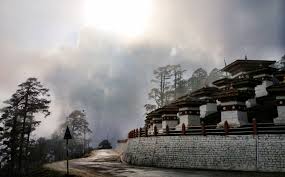Introduction
Have you heard of the land of tranquillity? Yes, you have
guessed it right. It is Bhutan. It is a landlocked country which is nestled in
the eastern Himalayas. When tourists visit this country, true to its legend, they
lose track of time. This is primarily due to the presence of serene nature, and
colourful culture and tradition. The landlocked country is famously dotted with
colourful dzongs and serene monasteries. In Bhutanese language, dzongs are
nothing but small fortresses. Being a secluded country buried deep in the Himalayas,
the culture and traditions grew different from the rest of the civilization in the
Eastern region. In this blog, we will list out some of the best visited region
in this country.
- Thimphu: This is the capital of Bhutan. This capital city is known for the presence of National Memorial Chorten where the people from the various parts of the country assemble to offer their prayers. The city is also home to the country’s revered monarchy. In fact, it is the only capital city in the world where there are no traffic lights to control vehicular movement. This primarily due to the absence of traffic jams on roads.
- Tashichho Dzong: This beautiful little fort is situated to the north of the capital city Thimphu on the western banks of the river Wang Chu. It blends seamlessly well with the beautiful surrounding valley. Noted for the regal splendour, the dzong was once home to the National Assembly. It currently houses the secretariat, throne room, the offices of the monarch and ministries of home affairs and finance.
- National Memorial Chorten: Located in the south-central part of the capital city, this impressive chorten is crowned by its golden spire. This memorial was built in 1974 to honour the third king Jigme Dorji Wangchuck. His Majesty is also known as the Father of Modern Bhutan.
- Dochula Pass: It is situated at an elevation of 3100 meters from sea level. Travelers moving towards central Bhutan can have the spectacular views of the Himalayan mountain ranges at this pass, which is about 30 kilometres from the capital city. The fluttering colourful Buddhist prayer flags dotting the pass add more beauty to the scenery. The visitors can also see tall snow-capped trees standing in the surrounding valley.
- Paro Valley: It is surrounded by Himalayan ranges. The valley derives its name from a small and beautiful town that it surrounds. Paro town has many sites known in the international tourist circuit. They include Taktstang Monastery and the National Museum. The latter one is visited by thousands of visitors each year. Located at the northern end of the valley is the 7300-meter-high Mount Jomolhari. This mountain range looms over the town and is home to a glacier that feeds the Pachu River flowing through the valley.
- National Museum: This Paro-based museum is housed in a 17th century watchtower. The museum is home to numerous bronze statues, handicrafts and paintings that depict the history and cultural heritage of the country. These exhibits showcase 3000 works of Bhutanese art.
- Taktsang Monastery: It is built on a 3000-metre-high precipice. Hence, the visitors to this monastery have to take a treacherous winding path in the Paro Valley. However, it is a worth-taking exercise. On reaching the monastery, one can hear tranquil sounds of the prayers and chanting of Buddhist monks. It was originally built in the year 1692. There was a massive fire at the monastery in 1998 that charred the structure. Hence, it was rebuilt later to house the Buddhist monks and preserve their thousands-year-old customs.
- Punakha Dzong: It is a 590-foot-long and 236-foot-wide
dzong located in the Punakha Valley at the confluence of Pho Chu and the Mo Chu
Rivers. Known also as Pungathen Dechen, the dzong is mainly divided into three
courtyards. Cut away from the city nearby, the fort is bordered by tall
Jacarandas trees. It famously hosts an annual Demoche festival in the month of
February or March. This famous structure has withstood severe earthquakes and
wild fire over the years.















0 Post a Comment:
Post a Comment